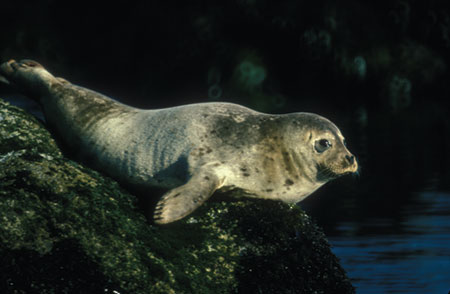Marine mammals succumbing to dual-parasite infections
Scientists with the National Institute of Allergy and Infectious Diseases have found a link between severe illness and co-infection with Sarcocystis neurona and Toxoplasma gondii in more than 150 marine mammals that died between 2004 and 2009 in the Pacific Northwest.
Such widespread polyparasitism among marine mammals indicates pervasive contamination of waterways by zoonotic agents, the scientists concluded. Moreover, the significant associations between co-infection and mortality rate and between co-infection and severity of protozoal encephalitis suggested that polyparasitism was an important factor contributing to disease severity in marine mammals.

The NIAID, part of the National Institutes of Health, collaborated with investigators in Washington state and Canada in the research, which was published online May 24 in the open-access journal PLoS Neglected Tropical Diseases.
Necropsies were performed on 151 marine mammals that were suspected to have parasitic encephalitis. The animals included several kinds of seals and sea lions, Northern sea otters, a Pacific white-sided dolphin, porpoises, and three species of whale. An additional 10 animals, all healthy adult California sea lions that were euthanized in the Columbia River to protect fish stocks, were included in the study as controls.
Hundreds of brain, heart, lymph node, and other tissue samples were examined. "Our techniques are unbiased in that we do not directly search for any particular species of parasite," said lead researcher Michael Grigg, PhD, of the NIAID Laboratory of Parasitic Diseases. "Rather, the screens simply reveal evidence of any parasite in the tissue being studied."
Parasites were found in 147 of the 161 animals studied—32 were infected with T gondii, 37 with S neurona, and 62 with both parasites. The remaining 16 animals were infected with various other parasites, including several that had not been detected before in any kind of animal. Notably, all 10 healthy animals were infected with either or both T gondii and S neurona.
"The presence of T gondii did not surprise us, but the abundance of S neurona infections was quite unexpected," Dr. Grigg said.
The most remarkable finding of our study was the exacerbating role that S neurona appears to play in causing more severe disease symptoms in those animals that are also infected with T gondii
Michael Grigg, PhD, National Institute of Allergy and Infectious Diseases Laboratory of Parasitic Diseases
Researchers theorize that S neurona has been introduced into the Pacific Northwest by opossums, which have been expanding their range northward from California and shed an infectious form of the parasite in their feces. Ample rainfall in the region provides an easy route for infected feces to enter inland and coastal waterways and then contaminate shellfish and other foods eaten by marine mammals.
"The most remarkable finding of our study was the exacerbating role that S neurona appears to play in causing more severe disease symptoms in those animals that are also infected with T gondii," Dr. Grigg said.
Among animals for which parasitic infection was the probable cause of death, there was evidence of more severe brain tissue inflammation in the co-infected animals than in those infected by either S neurona or T gondii alone. The two parasites are closely related, and other studies had suggested that acquired immunity after infection of an animal with one of these parasites might protect it from severe illness following infection with the other. Dr. Grigg noted that was not the case in this study, however.
The study results also hinted that animals with lowered immunity, such as pregnant or nursing females or very young animals, were more likely to have worse signs when co-infected with T gondii and S neurona.
"Identifying the threads that connect these parasites from wild and domestic land animals to marine mammals helps us to see ways that those threads might be cut," Dr. Grigg said. Managing feral cat and opossum populations, he added, is one way of preventing parasites from entering the marine food chain.
The study, "Polyparasitism Is Associated with Increased Disease Severity in Toxoplasma gondii-Infected Marine Sentinel Species," is available online at www.plosntds.org.